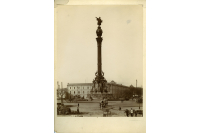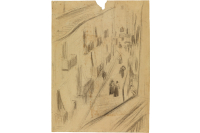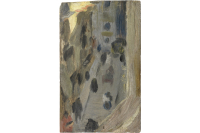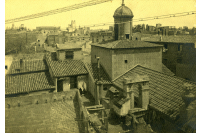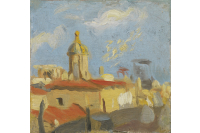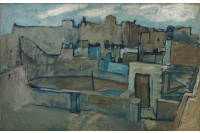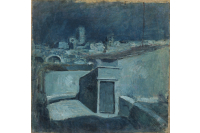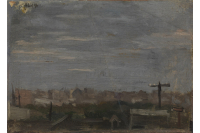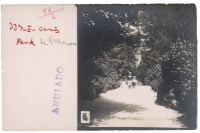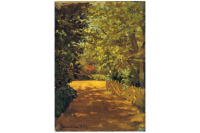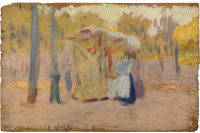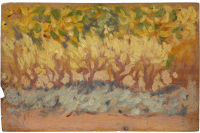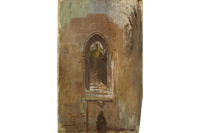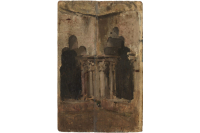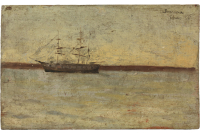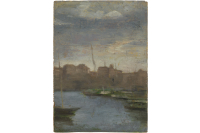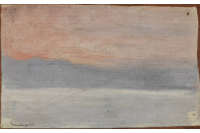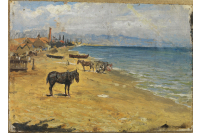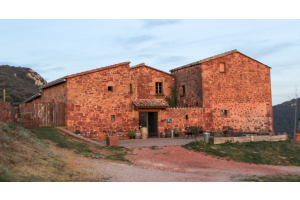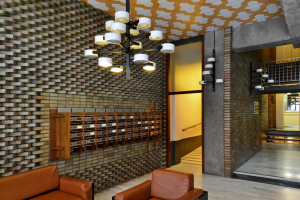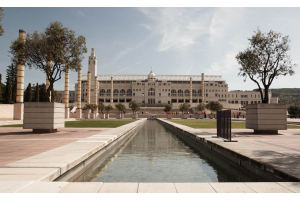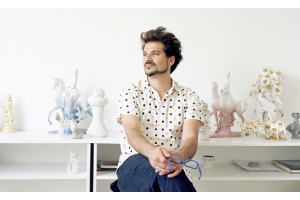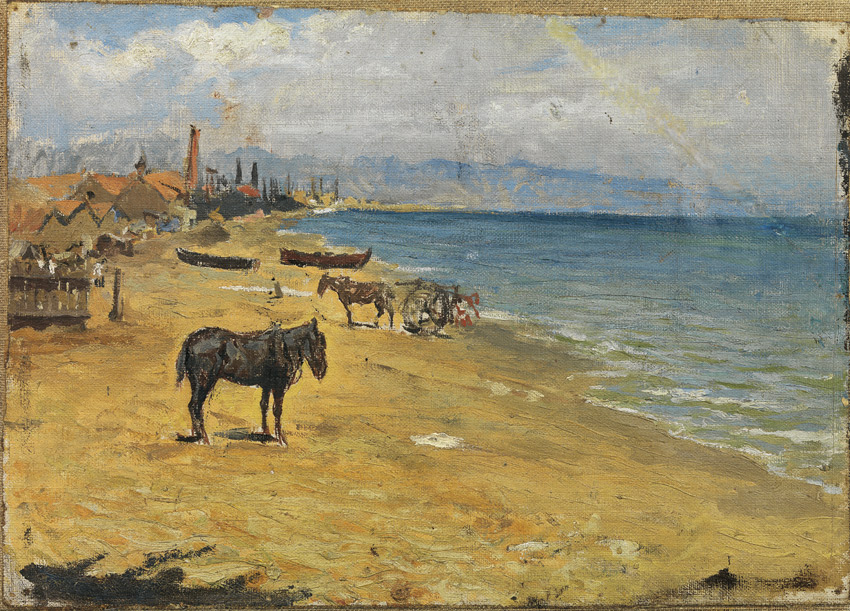
The landscape painting genre gained great momentum from the mid-19th century onwards. Picasso experienced a flourishing in Málaga alongside his father, with the arrival of painters from the Valencian school, trained at the Royal Academy of Fine Arts of San Carlos - such as Bernardo Ferrándiz and Antonio Muñoz Degrain - which was decisive for the consolidation of the school in Málaga. These and other artists shared a taste for the light, colour, bustle and joy of the Mediterranean, a taste that, years later, Picasso would fully exploit in painting, drawing and ceramics.
Barcelona at the turn of the century, where industrial and commercial developments were converging, was experiencing an artistic and cultural boom in which innovative movements were developing. Picasso, during his first years in the city, lived this atmosphere and it did not take long for him to integrate into the avant-garde milieu that had its epicentre in the brewery Els Quatre Gats.
 Pablo Picasso Beach Barceloneta, 1896 Oil on canvas.
Pablo Picasso Beach Barceloneta, 1896 Oil on canvas.
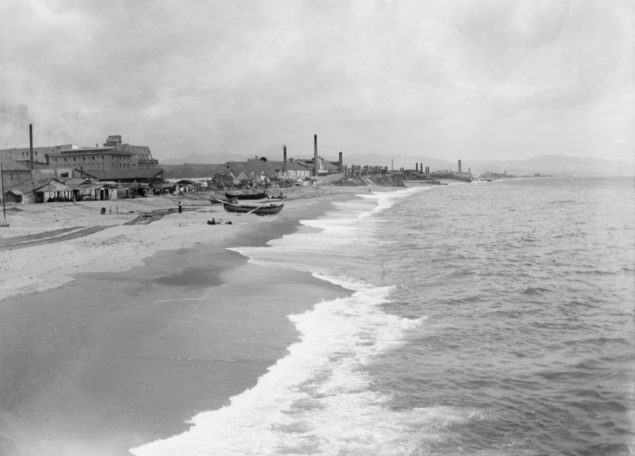 Màrius Aguirre Serrat-Calvó Factories near the beach in Barcelona 1888-1910 © Photographic Archive of the Centre Excursionista de Catalunya.
Màrius Aguirre Serrat-Calvó Factories near the beach in Barcelona 1888-1910 © Photographic Archive of the Centre Excursionista de Catalunya.
The harbours are a prelude and are combined with panoramic views of familiar coastal areas. Their compositional structure is marked by a maritime duality, and both the paintings and watercolours show us an emotional perception of space that manifests itself in the ethereal vapidity of the surroundings, in some cases close to Whistler, an artist who catalysed the Impressionist and Symbolist currents and who was quite well known among Catalan painters of the time.
 Pablo Picasso Man sitting on the beach Barceloneta Barcelona, 1895-1896 Oil on wood.
Pablo Picasso Man sitting on the beach Barceloneta Barcelona, 1895-1896 Oil on wood.
 Pablo Picasso Mountains of Marina Barcelona, 1896 Oil on canvas glued to wood.
Pablo Picasso Mountains of Marina Barcelona, 1896 Oil on canvas glued to wood.
 Pablo Picasso Port of Barcelona Barcelona, 1895-1896 Oil on wood.
Pablo Picasso Port of Barcelona Barcelona, 1895-1896 Oil on wood.
In January 1897, Picasso focused on La Barceloneta, as seen from the Moll de la Fusta, where the sheds were located, and recreated the first line of the sea in the fishing district.
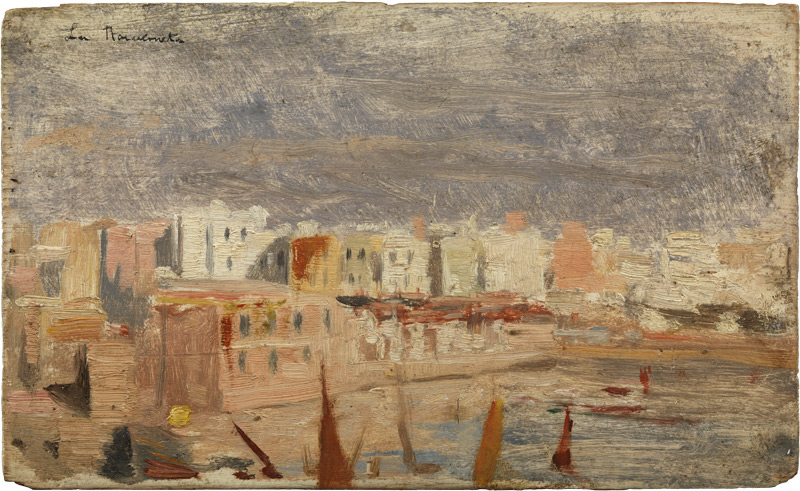 Pablo Picasso Barceloneta Barcelona, January 1897 Oil on wood.
Pablo Picasso Barceloneta Barcelona, January 1897 Oil on wood.
 Pablo Picasso Falochron with sailboat Barcelona, February 1896 Oil on wood.
Pablo Picasso Falochron with sailboat Barcelona, February 1896 Oil on wood.
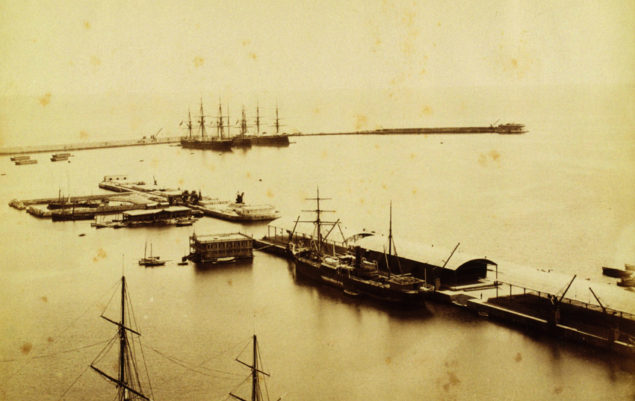 Antoni Esplugas Port c. 1890 Copy album Barcelona photographic archive.
Antoni Esplugas Port c. 1890 Copy album Barcelona photographic archive.
On the breakwater with the sailboat, Picasso turned the defensive causeway into a line separating the sea from the sky.❤
BARCELONA HERITAGE
The cultural climate of Catalonia at the end of the century prompted a systematic study of ancient Barcelona and other parts of Catalan geography. The desire to recover the historical and artistic heritage and the historical interpretation of Catalonia's origins was linked to the growing Catalan movement, which began a search for a memorable past that was conducive to the rebirth of the country's political and cultural personality. Picasso breathed at least this atmosphere.
Historic Barcelona coexisted with modern Barcelona and Picasso recreated the landscapes of the emblematic sites of Ciutat Vella's religious architectural heritage. His gaze stopped at the cloisters of two religious buildings of very different styles: the Romanesque monastery of Sant Pau del Camp and the Gothic cathedral.
 Pablo Picasso Corner of the Monastery of Sant Pau del Camp Barcelona, December 1896.
Pablo Picasso Corner of the Monastery of Sant Pau del Camp Barcelona, December 1896.

Unknown Cloister of the Church of Sant Pau del Camp 1923.
Sant Pau del Camp, located in the Raval district, is one of the few Romanesque buildings in Barcelona. It is an architectural complex dating from the 12th century, the most important part of which is the cloister, distinguished by the uniqueness of its polyhedral arches (three and five panels).
 Pablo Picasso Detail of the Monastery of Barcelona Cathedral Barcelona, 1896 Oil on panel.
Pablo Picasso Detail of the Monastery of Barcelona Cathedral Barcelona, 1896 Oil on panel.
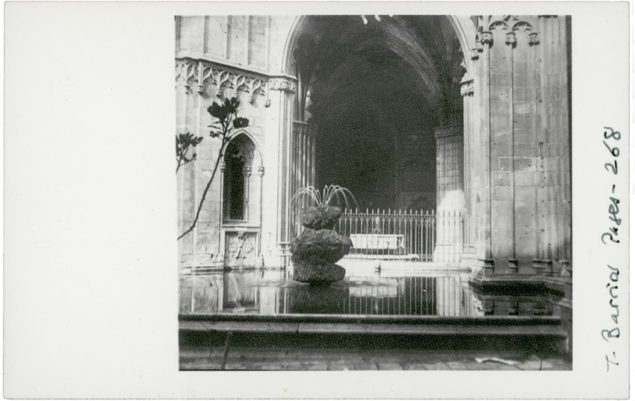
Teresa Barrios Pages Krużganki katedry 1948-1960 Fundacja Amatller d'Art Hispànic. Arxiu Mas.
In the same year, 1896, Picasso recreated the cloister of Barcelona Cathedral (built between the 13th and 19th centuries) in various oils on small-format wood. Based on the Gothic portal of Barcelona Cathedral, he recreated the door connecting the cloister to the Chapel of Saint Lucia, an example of flamboyant Gothic with archivolts and columns with decorated capitals, basically with floral and geometric motifs.
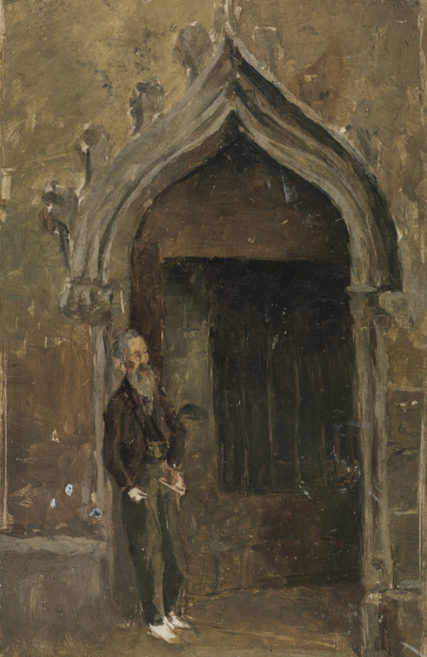 Pablo Picasso Man leaning on a Gothic portal in Barcelona Cathedral Barcelona, 1896 Oil on wood.
Pablo Picasso Man leaning on a Gothic portal in Barcelona Cathedral Barcelona, 1896 Oil on wood.
CONTEMPORARY BARCELONA
Barcelona underwent major changes in the last third of the 19th century. The liberal revolution of 1868, La Gloriosa, led to the incorporation of pristine urban space into the city with the creation of the Parc de la Ciutadella, part of which hosted the Universal Exhibition of 1888. And furthermore, the great urban reform of the Eixample, the urbanisation of the seafront and the cleansing of the old city, was woven in.
The Ruiz Picasso family rented a flat on Reina Cristina Street, 3, corner with Llauder (listed at number 4 of this street). In the area was the modern Ciutadella Park, and next to the Ruiz Picassos' house were the En Xifré Houses, the first modern block of flats in Barcelona. On the roof of the building are water tanks for domestic use, topped by a kind of dome, which were visible from the roof of Picasso's house.
 Pablo Picasso Roof of the houses En Xifré Barcelona, 4 October 1895 Oil on wood.
Pablo Picasso Roof of the houses En Xifré Barcelona, 4 October 1895 Oil on wood.
Picasso often went to the Parc de la Ciutadella (formerly Parc de Ribera). Palau i Fabre notes (Picasso lives. 1881-1907, 1980), as confirmed by the artist himself, that he visited it with his mother, Mme María, and his sister Lola. The name of the park recalls the existence of the military citadel built by Philip V at the end of the War of Succession. A sign of repression, it was hated by citizens who did not stop until it was demolished.

